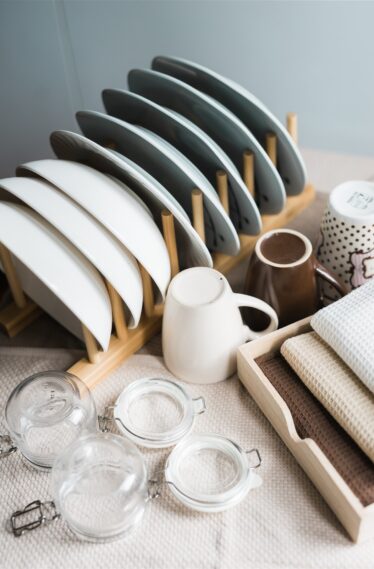Six kitchen replacements for a waste-free life
1. Stop using plastic straws

Glass straws, paper straws, metal straws, silicone straws and bamboo straws are all excellent eco-friendly alternatives to plastic straws.
Because of their functionality, metal straws are slightly ahead of the competition. They are also available in a variety of colours, which adds to their aesthetic appeal.
Paper straws, on the other hand, have a peculiar flavour and should be chosen last in order to help our environment.
Bamboo straws are probably the best solutions in terms of the process how are they being made, but you need to have a bamboo plant near you. If you are buying one, check that is not glued or coated because it won’t be able to go in a dishwasher.
Glass straws are a fantastic solution, but they are prone to breakage.
Silicone straws are a gentler option than metal or glass straws. They are great for children because we don’t have to worry about them unintentionally hitting their teeth or biting a hard straw.
Why are plastic straws bad?
Plastic straws are non-biodegradable, which means that bacteria and other insects will be unable to digest them once they reach their final destination — the landfill. This would result in long-term degradation, as well as the release of hazardous compounds like bisphenol A (BPA), which has been connected to pollution and health issues.
In most situations, they are also non-recyclable. The majority of them are classified as category 5 plastic, which is rarely recyclable and, even if it were, is often sorted out at automated recycling factories and sent to landfill anyhow.
Plastic straws are frequently blown out of trash bins, garbage vehicles, and landfill sites by the wind since they are small and light. They can then find their way to watercourses and end up in the sea.
Finally, they endanger living organisms. Birds eating at waste areas may consume straws, along with other small plastic items. Marine mammal species are known to have eaten or been entangled in plastic and therefor killed by plastic pollution. When plastic straws reach the water, they can clump together with other plastic waste to form massive floating piles on the surface. These masses can block sunlight from reaching algae and plankton below the water’s surface, preventing them from converting it into essential nutrients. The entire marine food web can be impacted if algae and plankton populations are threatened.
This zero-waste swap is simple, and it would have a massive impact if everyone did it. It would be a shame if you didn’t add this to your to-do list.
2. Cloths instead of paper towels

It may seem impossible to avoid using paper towels in the kitchen, but after the second or third day, it will feel so natural that you will wonder why you didn’t do it sooner.
The trick is to have a special cloth just for the floor or very severe spills like a pet’s incidents. Keep it under the sink and soak separately, if necessary, in hot water and vinegar, before placing them in the washing machine.
Using old t-shirts, towels, or pillowcases cut up and fashioned into cloth napkins is a terrific way to reuse them and give them a second life. To avoid being bothered by stains, use darker colours.
Where to keep cloth napkins?
In terms of organization, keep the clean and dry ones in a drawer, folded with KonMari method. This will save you a lot of room. If your regular laundry bin isn’t close by, simply drop the dirty napkins into your favourite basket or a tiny bin placed in the kitchen.
If they get wet, hang a jute string above the kitchen sink or, better yet, on a balcony or window close to the kitchen if you have one. I hang them there to dry first, then put them in the basket. I also hang other plastic packaging in this manner after cleaning it so that it is ready for recycling.
Do we waste more water by using cloth napkins and towels?
No, you’ll wash them with the rest of your regular laundry, and the extra water for that is nothing in comparison to the amount they use when producing paper towels and similar products.
What are the other advantages of using cloth napkins?
Paper towels are frequently packaged in plastic, so you will be reducing your plastic usage as well. The second advantage is financial; it may not appear to be a significant cost saving at first, but when added together, you can notice the difference.
Why is it a bad idea to use paper towels or anything made of paper?
The pulp and paper industry is a major contributor to deforestation and is partly to blame for the extinction of some forest-dwelling species. Technically speaking, the life cycle of paper and wood is damaging to the environment from beginning to end. It begins with the chopping down of a tree and ends its life by being burned – which releases carbon dioxide in the atmosphere. Water is also consumed in the manufacture of paper. Each sheet of A4 paper uses 10 litres of water.
Wood and paper, on the other hand, are our most abundant natural resources, making our lives easier and our homes warmer. It is recyclable, and we have the ability to plant a new tree for each one that is cut down. We will be a part of the change we seek if we utilize it when we genuinely need it, rather than how we use it now.
3. Dish towel instead of a plastic dish rack

Another fantastic application is dish towel as a drying pad. All of those dish racks (which are usually plastic) collect water and are difficult to clean. Not to mention that they take up counter space all of the time. By using the cloth, you can remove everything and free up kitchen counter space. When the dish drying is done, I just hang it to dry and place in the laundry basket.
If you’re worried about your pile falling and breaking, I recommend a metal or bamboo plate holder that takes up little room and can be quickly stowed. Use a glass or a cup, that you can easily wash later, to dry utensils.
4. Replace your kitchen sponges

Replace your kitchen sponge with one of these zero waste alternatives: loofah sponge, silicone sponge, dishwashing brush, or cloth sponge.
Loofah sponge is a cucumber-family plant that you may simply grow at home. They scrub well yet aren’t as abrasive as steel wool sponges. They can easily be composted once they’ve run out.
Silicone sponge holds less bacteria than traditional sponges, is easy to clean, dishwasher safe, and lasts a long time. The main drawback is that they don`t hold soap as well as conventional ones, so you might have to use more detergent than usual.
The dishwashing brush is made of wood handle and plant fibres as bristles. It’s quite long-lasting, and all you have to do is replace the compostable bristle.
A cloth sponge is the ideal zero-waste alternative because we are reusing and giving a second life to an old t-shirt or kitchen cloth. It’s simple to sew the ends together, and when applying a detergent, it produces foam. Still not quite as good as the regular one but enough to make your transition easier.
5. Bring your own reusable coffee mug and water bottle to go

Bringing your own coffee mug and water bottle not only helps the environment, but it also makes your drink temperature last longer, your beverage will taste better because it doesn`t leach harmful chemicals, such as BPA, it saves you money and lasts a long time as a product.
Make sure you get one made of stainless steel or glass. Finally, they are quite fashionable, so take your time and choose a design that really sparks joy in you.
6. Bring your own utensils and containers for food

Similar to coffee mugs and water bottles, try to carry your own utensils and containers if you are taking food to go or if you are buying some type of food in supermarket that they usually pack in plastic containers. Glass containers with bamboo or glass lids are more durable and aesthetically beautiful though they are heavier to carry around. Plastic containers are prone to staining from the sauces we eat, as well as being easily scratched. If you do choose to use the plastic ones, make sure they are Bisphenol A (BPA) – free, a chemical that affects the endocrine system.
When it comes to utensils, I set aside a specific set and store them in a smaller cloth that I use as a napkin when I eat. If the weight bothers you, consider using a wooden or bamboo utensil solely for that purpose.

